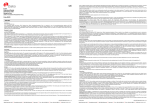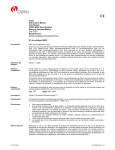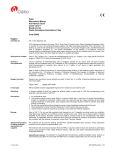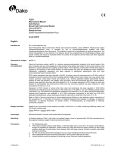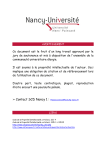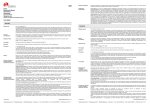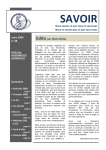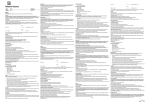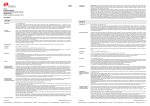Download Monoclonal Mouse
Transcript
FLEX Monoclonal Mouse Anti-Human CD99, MIC2 Gene Product Ewing’s Sarcoma Marker Clone 12E7 Ready-to-Use (Dako Autostainer/Autostainer Plus) Code IS057 English Intended use For in vitro diagnostic use. FLEX Monoclonal Mouse Anti-Human CD99, MIC2 Gene Product, Ewing’s Sarcoma Marker, Clone 12E7, Ready-to-Use, (Dako Autostainer/Autostainer Plus), is intended for use in immunohistochemistry together with Dako Autostainer/Autostainer Plus instruments. This antibody is useful for the identification of glioblastomas and ependymomas of the CNS, certain islet cell tumors of the pancreas, particularly Ewing's Sarcoma (ES), and primitive peripheral neuroectodermal tumors (pPNET). The clinical interpretation of any staining or its absence should be complemented by morphological studies using proper controls and should be evaluated within the context of the patient's clinical history and other diagnostic tests by a qualified pathologist. Synonyms for antigen p30/32mic2, CD99 Summary and explanation The MIC2 gene is a pseudoautosomal gene located on the short arms of both the X and Y chromosomes. The gene products are glycoproteins of similar molecular weight designated p30 and p32 (3-5). The proteins encoded by the MIC2 gene are neuraminidase- and protease-sensitive. In red cells, the MIC2 gene is regulated by the Xlinked XG gene, resulting in a quantitative polymorphism for levels of the MIC2 gene product (6). Refer to Dako’s General Instructions for Immunohistochemical Staining or the detection system instructions of IHC procedures for: 1) Principle of Procedure, 2) Materials Required, Not Supplied, 3) Storage, 4) Specimen Preparation, 5) Staining Procedure, 6) Quality Control, 7) Troubleshooting, 8) Interpretation of Staining, 9) General Limitations. Reagent provided Ready-to-use monoclonal mouse antibody provided in liquid form in a buffer containing stabilizing protein and 0.015 mol/L NaN3. Clone: 12E7 Isotype: IgG1, kappa Immunogen Acute lymphocytic leukemia T-cells (1) Specificity The antibody recognizes the products of the MIC2 gene and has been shown to have similar or identical reactivity as monoclonal antibodies HBA-71 and RFB-1 (2,5). Precautions 1. For professional users. 2. This product contains sodium azide (NaN3), a chemical highly toxic in pure form. At product concentrations, though not classified as hazardous, sodium azide may react with lead and copper plumbing to form highly explosive build-ups of metal azides. Upon disposal, flush with large volumes of water to prevent metal azide build-up in plumbing. 3. As with any product derived from biological sources, proper handling procedures should be used. 4. Wear appropriate Personal Protective Equipment to avoid contact with eyes and skin. 5. Unused solution should be disposed of according to local, State and Federal regulations. Storage Store at 2-8 °C. Do not use after expiration date stamped on vial. If reagents are stored under any conditions other than those specified, the conditions must be verified by the user. There are no obvious signs to indicate instability of this product. Therefore, positive and negative controls should be run simultaneously with patient specimens. If unexpected staining is observed which cannot be explained by variations in laboratory procedures and a problem with the antibody is suspected, contact Dako Technical Support. Specimen preparation including materials required but not supplied The antibody can be used for labeling formalin-fixed, paraffin-embedded tissue sections. Tissue specimens should be cut into sections of approximately 4 µm. Pre-treatment with heat-induced epitope retrieval (HIER) is required. Optimal results are obtained by pretreating tissues using EnVision FLEX Target Retrieval Solution, High pH (10x) (Dako Autostainer/Autostainer Plus) (Code K8010/K8014). Deparaffinized sections: Pre-treatment of deparaffinized formalin-fixed, paraffin-embedded tissue sections is recommended using Dako PT Link (Code PT100/PT101). For details, please refer to the PT Link User Guide. (117268-001) 307130EFG_001 p. 1/7 Follow the pre-treatment procedure outlined in the package insert for EnVision FLEX Target Retrieval Solution, High pH (10x) (Dako Autostainer/Autostainer Plus) (Code K8010/K8014). The following parameters should be used for PT Link: Pre-heat temperature: 65 °C; epitope retrieval temperature and time: 97 °C for 20 (±1) minutes; cool down to 65 °C. Rinse sections with diluted room temperature EnVision FLEX Wash Buffer (10x) (Dako Autostainer/Autostainer Plus) (Code K8010). Paraffin-embedded sections: As alternative specimen preparation, both deparaffinization and epitope retrieval can be performed in the PT Link using a modified procedure. See the PT Link User Guide for instructions. After the staining procedure has been completed, the sections must be dehydrated, cleared and mounted using permanent mounting medium. The tissue sections should not dry out during the treatment or during the following immunohistochemical staining procedure. For greater adherence of tissue sections to glass slides, the use of Dako Silanized Slides (Code S3003) is recommended. Staining procedure including materials required but not supplied The recommended visualization system is EnVision FLEX, High pH (Dako Autostainer/Autostainer Plus) (Code K8010). The staining steps and incubation times are pre-programmed into the software of Dako Autostainer/Autostainer Plus instruments, using the following protocols: Template protocol: FLEXRTU2 (200 uL dispense volume) or FLEXRTU3 (300 uL dispense volume) Autoprogram (without counterstaining): CD99 or Autoprogram (with counterstaining): CD99H The Auxiliary step should be set to “rinse buffer” in staining runs with ≤10 slides. For staining runs with >10 slides the Auxiliary step should be set to “none.” This ascertains comparable wash times. All incubation steps should be performed at room temperature. For details, please refer to the Operator’s Manual for the dedicated instrument. If the protocols are not available on the used Dako Autostainer instrument, please contact Dako Technical Services. Optimal conditions may vary depending on specimen and preparation methods, and should be determined by each individual laboratory. If the evaluating pathologist should desire a different staining intensity, a Dako Application Specialist/Technical Service Specialist can be contacted for information on re-programming of the protocol. Verify that the performance of the adjusted protocol is still valid by evaluating that the staining pattern is identical to the staining pattern described in “Performance characteristics.” Counterstaining in hematoxylin is recommended using EnVision FLEX Hematoxylin (Dako Autostainer/Autostainer Plus) (Code K8018). Non-aqueous, permanent mounting medium is recommended. Positive and negative controls should be run simultaneously using the same protocol as the patient specimens. The positive control tissue should include cortical thymocytes and the cells/structures should display reaction patterns as described for this tissue in “Performance characteristics” in all positive specimens. The recommended negative control reagent is FLEX Negative Control, Mouse (Dako Autostainer/Autostainer Plus) (Code IS750). Staining interpretation The cellular staining pattern is membranous. Performance characteristics Normal tissues: The MIC2 gene products are expressed on the cell membrane of some lymphocytes (bone marrow, lymph nodes and spleen), cortical thymocytes, granulosa cells of the ovary, most Langerhans' islet cells, CNS ependymal cells, Sertoli's cells of the testis and in a few cases, endothelial cells of single blood vessels (5). Abnormal tissues: A study of 70 different tumors has shown that among neoplastic tissues, only glioblastoma and ependymoma of the CNS and certain islet cell tumors of the pancreas reacted positively (6). The MIC2 gene products are most strongly expressed on the cell membrane of Ewing’s Sarcoma (ES), primitive peripheral neuroectodermal tumors (pPNET), uterine stromal neoplasm and sex cord-stromal tumors. Consequently the demonstration of the gene products allows for the differentiation of these tumors from other round cell tumors of childhood and adolescence (3,5-10). (117268-001) 307130EFG_001 p. 2/7 Français Réf. IS057 Utilisation prévue Pour utilisation diagnostique in vitro. FLEX Monoclonal Mouse Anti-Human CD99, MIC2 Gene Product, Ewing’s Sarcoma Marker, clone 12E7, Readyto-Use, (Dako Autostainer/Autostainer Plus), est destiné à une utilisation en immunohistochimie avec les instruments Dako Autostainer/Autostainer Plus. Cet anticorps est utile pour l’identification des glioblastomes et des épendymomes du système nerveux central, de certaines tumeurs des îlots de Langerhans pancréatiques, en particulier le sarcome d’Ewing (SE) et des tumeurs primitives neuro-ectodermiques périphériques (pPNET). L’interprétation clinique de toute coloration ou son absence doit être complétée par des études morphologiques en utilisant des contrôles appropriés et doit être évaluée en fonction des antécédents cliniques du patient et d’autres tests diagnostiques par un pathologiste qualifié. Synonymes de l’antigène p30/32mic2, CD99 Résumé et explication Le gène MIC2 est un gène pseudo-autosomique situé sur les bras courts des chromosomes X et Y. Les produits géniques sont des glycoprotéines de poids moléculaire similaire appelées p30 et p32 (3-5). Les protéines codées par le gène MIC2 sont sensibles à la neuraminidase et à la protéase. Dans les globules rouges, le gène MIC2 est régulé par le gène réticulé XG, ce qui entraîne un polymorphisme quantitatif pour des niveaux de produit du gène MIC2 (6). Se référer aux Instructions générales de coloration immunohistochimique de Dako ou aux instructions du système de détection relatives aux procédures IHC pour plus d’informations concernant les points suivants : 1) Principe de procédure, 2) Matériels requis mais non fournis, 3) Conservation, 4) Préparation des échantillons, 5) Procédure de coloration, 6) Contrôle qualité, 7) Dépannage, 8) Interprétation de la coloration, 9) Limites générales. Réactifs fournis Anticorps monoclonal de souris prêt à l’emploi fourni sous forme liquide dans un tampon contenant une protéine stabilisante et 0,015 mol/L d’azide de sodium. Clone : 12E7 Isotype : IgG1, kappa Immunogène Lymphocytes T provenant d’une leucémie aiguë lymphocytaire (1) Spécificité L’anticorps reconnaît les produits du gène MIC2 et présente une réactivité similaire ou identique aux anticorps monoclonaux HBA-71 et RFB-1 (2,5). Précautions 1. Pour utilisateurs professionnels. 2. Ce produit contient de l’azide de sodium (NaN3), produit chimique hautement toxique dans sa forme pure. Aux concentrations du produit, bien que non classé comme dangereux, l’azide de sodium peut réagir avec le cuivre et le plomb des canalisations et former des accumulations d’azides métalliques hautement explosifs. Lors de l’élimination, rincer abondamment à l’eau pour éviter toute accumulation d’azide métallique dans les canalisations. 3. Comme avec tout produit d’origine biologique, des procédures de manipulation appropriées doivent être respectées. 4. Porter un vêtement de protection approprié pour éviter le contact avec les yeux et la peau. 5. Les solutions non utilisées doivent être éliminées conformément aux réglementations locales et nationales. Conservation Conserver entre 2 et 8 °C. Ne pas utiliser après la date de péremption imprimée sur le flacon. Si les réactifs sont conservés dans des conditions autres que celles indiquées, celles-ci doivent être validées par l’utilisateur. Il n’y a aucun signe évident indiquant l’instabilité de ce produit. Par conséquent, des contrôles positifs et négatifs doivent être testés en même temps que les échantillons de patient. Si une coloration inattendue est observée, qui ne peut être expliquée par un changement des procédures du laboratoire, et en cas de suspicion d’un problème lié à l’anticorps, contacter l’assistance technique de Dako. Préparation des échantillons y compris le matériel requis mais non fourni L’anticorps peut être utilisé pour le marquage des coupes de tissus inclus en paraffine et fixés au formol. L'épaisseur des coupes d'échantillons de tissu doit être d’environ 4 µm. Le prétraitement avec un démasquage d’épitope induit par la chaleur (HIER) est nécessaire. Des résultats optimaux sont obtenus en prétraitant les tissus à l’aide de la EnVision FLEX Target Retrieval Solution, High pH (10x), (Dako Autostainer/Autostainer Plus) (Réf. K8010/K8014). Coupes déparaffinées : Le pré-traitement des coupes de tissus déparaffinés fixés au formol et inclus en paraffine est recommandé à l’aide du Dako PT Link (Réf. PT100/PT101). Pour plus de détails, se référer au Guide d’utilisation du PT Link. Suivre la procédure de pré-traitement indiquée dans la notice pour la EnVision FLEX Target Retrieval Solution, High pH (10x), (Dako Autostainer/Autostainer Plus) (Réf. K8010/K8014). Les paramètres suivants doivent être utilisés pour le PT Link : Température de préchauffage : 65 °C; température et durée de restauration de l’épitope : 97 °C pour 20 (±1) minutes ; laisser refroidir jusqu’à 65 °C. Rincer les coupes avec un EnVision FLEX Wash Buffer (10x), dilué à température ambiante (Dako Autostainer/Autostainer Plus) (Réf. K8010). (117268-001) 307130EFG_001 p. 3/7 Coupes incluses en paraffine : Comme préparation alternative des échantillons, le déparaffinage et la restauration de l’épitope peuvent être réalisés dans le PT Link à l’aide d’une procédure modifiée. Se référer aux instructions du Guide d’utilisation du PT Link. Une fois que la procédure de coloration est terminée, les coupes doivent être déshydratées, lavées et montées à l’aide d’un milieu de montage permanent. Les coupes de tissus ne doivent pas sécher lors du traitement ou lors de la procédure de coloration immunohistochimique suivante. Pour une meilleure adhérence des coupes de tissus sur les lames de verre, il est recommandé d’utiliser des lames Dako Silanized Slides (Réf. S3003). Procédure de coloration y compris le matériel requis mais non fourni Le système de visualisation recommandé est le EnVision FLEX, High pH, (Dako Autostainer/Autostainer Plus) (Réf. K8010). Les étapes de coloration et d’incubation sont préprogrammées dans le logiciel des instruments Dako Autostainer/Autostainer Plus, à l’aide des protocoles suivants : Protocole modèle : FLEXRTU2 (volume de distribution de 200 µl) ou FLEXRTU3 (volume de distribution de 300 µl) Autoprogram (sans contre-coloration) : CD99 ou Autoprogram (avec contre-coloration) : CD99H L’étape Auxiliary doit être réglée sur « rinse buffer » lors des cycles de coloration avec ≤10 lames. Pour les cycles de coloration de >10 lames, l’étape Auxiliary doit être réglée sur « none ». Cela confirme des temps de lavage comparables. Toutes les étapes d’incubation doivent être effectuées à température ambiante. Pour plus de détails, se référer au Manuel de l’opérateur spécifique à l'instrument. Si les protocoles ne sont pas disponibles sur l’instrument Dako Autostainer utilisé, contacter le service technique de Dako. Les conditions optimales peuvent varier en fonction du prélèvement et des méthodes de préparation, et doivent être déterminées par chaque laboratoire individuellement. Si le pathologiste qui réalise l’évaluation désire une intensité de coloration différente, un spécialiste d’application/spécialiste du service technique de Dako peut être contacté pour obtenir des informations sur la re-programmation du protocole. Vérifier que l'exécution du protocole modifié est toujours valide en vérifiant que le schéma de coloration est identique au schéma de coloration décrit dans les « Caractéristiques de performance ». Il est recommandé d’effectuer une contre-coloration à l’aide d’hématoxyline EnVision FLEX Hematoxylin, (Dako Autostainer/Autostainer Plus) (Réf. K8018). L’utilisation d’un milieu de montage permanent non aqueux est recommandée. Des contrôles positifs et négatifs doivent être réalisés en même temps et avec le même protocole que les échantillons du patient. Le contrôle de tissu positif doit comprendre les thymocytes corticaux et les cellules/structures doivent présenter des schémas de réaction tels que décrits pour ces tissus dans les « Caractéristiques de performance » pour tous les échantillons positifs. Le contrôle négatif recommandé est le FLEX Negative Control, Mouse, (Dako Autostainer/Autostainer Plus) (Réf. IS750). Interprétation de la coloration Le schéma de coloration cellulaire est membranaire. Caractéristiques de performance Tissus sains : Les produits du gène MIC2 marquent la membrane cellulaire de certains lymphocytes (moelle osseuse, ganglions lymphatiques et rate), thymocytes corticaux, cellules de la granulosa ovarienne, de la plupart des îlots de Langerhans, des épendymocytes du système nerveux central, des cellules de Sertoli des testicules et, dans quelques cas, des cellules endothéliales de vaisseaux sanguins isolés (5). Tissus tumoraux : Une étude portant sur 70 tumeurs a montré que, parmi les tissus néoplasiques, seuls les glioblastomes et les épendymomes du SNC et certaines tumeurs des îlots de Langerhans pancréatiques réagissent positivement (6). Les produits du gène MIC2 sont plus fortement exprimés sur la membrane cellulaire du sarcome d’Ewing et des tumeurs primitives neuro-ectodermiques périphériques (pPNET), du néoplasme stromal utérin et des tumeurs stromales du cordon sexuel. Par conséquent, la mise en évidence des produits géniques permet de différencier ces tumeurs d’autres tumeurs à petites cellules rondes qui apparaissent dans l'enfance et à l'adolescence (3,5-10). (117268-001) 307130EFG_001 p. 4/7 Deutsch Code-Nr. IS057 Zweckbestimmung Zur In-vitro-Diagnostik. FLEX Monoclonal Mouse Anti-Human CD99, MIC2 Gene Product, Ewing’s Sarcoma Marker, Clone 12E7, Ready-to-Use, (Dako Autostainer/Autostainer Plus) ist zur Verwendung in der Immunhistochemie in Verbindung mit Dako Autostainer/Autostainer Plus-Geräten bestimmt. Dieser Antikörper ist hilfreich bei der Erkennung von Glioblastomen und Ependymomen des ZNS und bestimmten Pankreasinselzelltumoren, insbesondere das Ewing-Sarkom (ES) und primitive periphere neuroektodermale Tumore (pPNET). Die klinische Auswertung einer eventuell eintretenden Färbung sollte durch morphologische Studien mit ordnungsgemäßen Kontrollen ergänzt werden und von einem qualifizierten Pathologen unter Berücksichtigung der Krankengeschichte und anderer Diagnostiktests des Patienten vorgenommen werden. Synonyme für das Antigen p30/32mic2, CD99 Zusammenfassung und Erklärung Bei dem MIC2-Gen handelt es sich um ein pseudoautosomales Gen auf den kurzen Armen der X- und YChromosome. Die Genprodukte sind Glykoproteine mit ähnlichem Molekulargewicht: p30 und p32 (3–5). Die vom MIC2-Gen kodierten Proteine sind neuraminidase- und proteaseempfindlich. In roten Blutkörperchen wird das MIC2-Gen von dem an X gekoppelten XG-Gen gesteuert, was zu einem quantitativen Polymorphismus für die Pegel des MIC2-Genprodukts führt.(6) Folgende Angaben bitte den Allgemeinen Richtlinien zur immunhistochemischen Färbung von Dako oder den Anweisungen des Detektionssystems für IHC-Verfahren entnehmen: 1) Verfahrensprinzip, 2) Erforderliche, aber nicht mitgelieferte Materialien, 3) Aufbewahrung, 4) Vorbereitung der Probe, 5) Färbeverfahren, 6) Qualitätskontrolle, 7) Fehlersuche und -behebung, 8) Auswertung der Färbung, 9) Allgemeine Beschränkungen. Geliefertes Reagenz Gebrauchsfertiger, monoklonaler Maus-Antikörper in flüssiger Form in einem Puffer, der stabilisierendes Protein und 0,015 mol/L NaN3 enthält. Klon: 12E7 Isotyp: IgG1, Kappa Immunogen T-Zellen von Fällen akuter Lymphozytenleukämie (1) Spezifität Der Antikörper erkennt nachweislich die Produkte des MIC2-Gens und reagiert ähnlich oder gleich auf die monoklonalen Antikörper HBA-71 und RFB-1 (2,5). Vorsichtsmaßnahmen 1. Nur für Fachpersonal bestimmt. 2. Dieses Produkt enthält Natriumazid (NaN3), eine in reiner Form äußerst giftige Chemikalie. Natriumazid kann auch in als ungefährlich eingestuften Konzentrationen mit Blei- und Kupferrohren reagieren und hochexplosive Metallazide bilden. Nach der Entsorgung stets mit viel Wasser nachspülen, um Metallazidansammlungen in den Leitungen vorzubeugen. 3. Wie alle Produkte biologischen Ursprungs müssen auch diese entsprechend gehandhabt werden. 4. Geeignete Schutzkleidung tragen, um Augen- und Hautkontakt zu vermeiden. 5. Nicht verwendete Lösung ist entsprechend örtlichen, bundesstaatlichen und staatlichen Richtlinien zu entsorgen. Lagerung Bei 2–8 °C aufbewahren. Nach Ablauf des auf dem Fläschchen aufgedruckten Verfalldatums nicht mehr verwenden. Werden die Reagenzien unter anderen als den angegebenen Bedingungen aufbewahrt, müssen diese Bedingungen vom Benutzer validiert werden. Es gibt keine offensichtlichen Anzeichen für eine eventuelle Produktinstabilität. Positiv- und Negativkontrollen sollten daher zur gleichen Zeit wie die Patientenproben getestet werden. Falls es zu einer unerwarteten Färbung kommt, die sich nicht durch Unterschiede bei Laborverfahren erklären lässt und auf ein Problem mit dem Antikörper hindeutet, ist der technische Kundendienst von Dako zu verständigen. Vorbereitung der Probe und erforderliche, aber nicht mitgelieferte Materialien Der Antikörper eignet sich zur Markierung von formalinfixierten und paraffineingebetteten Gewebeschnitten. Gewebeproben sollten in Schnitte von ca. 4 µm Stärke geschnitten werden. Die Vorbehandlung durch hitzeinduzierte Epitopdemaskierung (HIER) ist erforderlich. Optimale Ergebnisse können durch Vorbehandlung der Gewebe mit EnVision™ FLEX Target Retrieval Solution, High pH (10x), (Dako Autostainer/Autostainer Plus) (Code-Nr. K8010/K8014) erzielt werden. Entparaffinierte Schnitte: Die Vorbehandlung der entparaffinierten, formalinfixierten, paraffineingebetteten Gewebeschnitte sollte mit Dako PT Link (Code-Nr. PT100/PT101) erfolgen. Weitere Informationen hierzu siehe PT Link-Benutzerhandbuch. (117268-001) 307130EFG_001 p. 5/7 Vorbehandlung gemäß der Beschreibung in der Packungsbeilage für EnVision™ FLEX Target Retrieval Solution, High pH (10x) (Dako Autostainer/Autostainer Plus) (Code-Nr. K8010/K8014) durchführen. Für PT Link sollten die folgenden Parameter verwendet werden: Vorwärmtemperatur: 65 °C; Temperatur und Zeit für Epitopdemaskierung: 97 °C für 20 (±1) Minuten; auf 65 °C abkühlen lassen. Schnitte mit auf Raumtemperatur gebrachtem, verdünntem EnVision™ FLEX Wash Buffer (10x) (Dako Autostainer/Autostainer Plus) (Code-Nr. K8010) abspülen. Paraffineingebettete Schnitte: Zur Probenpräparation kann für Entparaffinierung und Epitopdemaskierung im PT Link auch ein modifiziertes Verfahren verwendet werden. Weitere Informationen siehe PT LinkBenutzerhandbuch. Nach Abschluss des Färbeverfahrens müssen die Schnitte dehydriert, geklärt und unter Verwendung eines permanenten Fixiermittels auf die Objektträger aufgebracht werden. Die Gewebeschnitte dürfen während der Behandlung oder während des anschließenden immunhistochemischen Färbeverfahrens nicht austrocknen. Zur besseren Haftung der Gewebeschnitte an den Glasobjektträgern wird die Verwendung von Dako Silanized Slides (Code-Nr. S3003) empfohlen. Färbeverfahren und erforderliche, aber nicht mitgelieferte Materialien Das empfohlene Visualisierungssystem ist EnVision™ FLEX, High pH (Dako Autostainer/Autostainer Plus) (Code-Nr. K8010). Die Färbeschritte und Inkubationszeiten sind in der Software der Dako Autostainer/Autostainer Plus-Geräte mit den folgenden Protokollen vorprogrammiert: Matrix-Protokoll: FLEXRTU2 (200 µl Abgabevolumen) oder FLEXRTU3 (300 µl Abgabevolumen) Autoprogram (ohne Gegenfärbung): CD99 oder Autoprogram (mit Gegenfärbung): CD99H Bei Färbedurchläufen mit höchstens 10 Objektträgern sollte der „Zusatz“-Schritt auf „Pufferspülgang“ eingestellt werdenFür Färbedurchläufe mit mehr als 10 Objektträgern den „Zusatz“-Schritt auf „Keine“ einstellen. Dies gewährleistet vergleichbare Waschzeiten. Alle Inkubationsschritte sollten bei Raumtemperatur durchgeführt werden. Nähere Einzelheiten bitte dem Benutzerhandbuch für das jeweilige Gerät entnehmen. Wenn die Färbeprotokolle auf dem verwendeten Dako Autostainer-Gerät nicht verfügbar sind, bitte den Technischen Kundendienst von Dako verständigen. Optimale Bedingungen können je nach Probe und Präparationsverfahren unterschiedlich sein und sollten vom jeweiligen Labor selbst ermittelt werden. Falls der beurteilende Pathologe eine andere Färbungsintensität wünscht, kann ein Anwendungsspezialist oder Kundendiensttechniker von Dako bei der Neuprogrammierung des Protokolls helfen. Die Leistung des angepassten Protokolls muss verifiziert werden, indem gewährleistet wird, dass das Färbemuster mit dem unter „Leistungsmerkmale“ beschriebenen Färbemuster identisch ist. Die Gegenfärbung in Hämatoxylin sollte mit EnVision™ FLEX Hematoxylin (Dako Autostainer/Autostainer Plus) (Code-Nr. K8018) ausgeführt werden. Empfohlen wird ein nichtwässriges, permanentes Fixiermittel. Positiv- und Negativkontrollen sollten zur gleichen Zeit und mit demselben Protokoll wie die Patientenproben getestet werden. Das positive Kontrollgewebe sollte kortikalen Thymozyten enthalten und die Zellen/Strukturen müssen in allen positiven Proben die für dieses Gewebe unter „Leistungsmerkmale“ beschriebenen Reaktionsmuster aufweisen. Das empfohlene Negativ-Kontrollreagenz ist FLEX Negative Control, Mouse, (Dako Autostainer/Autostainer Plus) (Code-Nr. IS750). Auswertung der Färbung Das zelluläre Färbemuster ist membranös. Leistungsmerkmale Gesundes Gewebe: Die MIC2-Genprodukte werden auf der Zellmembran einiger Lymphozyten (Knochenmark, Lymphknoten und Milz), auf kortikalen Thymozyten, Granulosazellen der Eierstöcke, den meisten Langerhans’schen Inselzellen, Ependymalzellen des ZNS, Sertoli’schen Zellen der Hoden und, in wenigen Fällen, auf Endothelzellen einzelner Blutgefäße exprimiert (5). Pathologisches Gewebe: Eine Studie an 70 verschiedenen Tumoren ergab unter den neoplastischen Geweben nur bei Glioblastomen und Ependymomen des ZNS sowie bestimmten Pankreasinselzelltumoren eine positive Reaktion (6). Die Produkte des MIC2-Gens werden am deutlichsten auf der Zellmembran des Ewing-Sarkoms (ES), auf primitiven peripheren neuroektodermalen Tumoren (pPNET), auf stromalem Gebärmutterneoplasma und Keimstrang-Stromatumoren exprimiert. Der Nachweis dieser Genprodukte ermöglicht daher die Unterscheidung dieser Tumore von anderen Rundzellentumoren bei Kindern und Erwachsenen (3, 5–10). (117268-001) 307130EFG_001 p. 6/7 References Bibliographie Literaturangaben 1. Levy R, et al. A human thymus-leukemia antigen defined by hybridoma monoclonal antibodies. PNAS USA 1979; 76:6552 2. Latron F, et al. Immunochemical characterization of the human blood cell membrane glycoprotein recognized by the monoclonal antibodies 12E7. Biochem J 1987; 247:757 3. Fellinger EJ, et al. Biochemical and genetic characterization of the HBA71 Ewing's sarcoma cell surface antigen. Cancer Res 1991; 51:336 4. Goodfellow PN and Tippett P. A human quantitative polymorphism related to the Xg blood groups. Nature 1981; 289:404 5. Ambros IM, et al. MIC2 is a specific marker for Ewing's sarcoma and peripheral primitive neuroectodermal tumors. Cancer 1991; 67:1886 6. Fellinger EJ, et al. Immunohistochemical analysis of Ewing's Sarcoma cell surface antigen p30/32mic2. Amer J Pathol 1991; 139:317 7. Rettig WJ, et al. Ewing's Sarcoma: new approaches to histogenesis and molecular plasticity. Lab Invest 1992; 66:133 8. Fellinger EJ, et al. Comparison of cell surface HBA71 (p30/32mic2), neuron specific enolase, and vimentin in the immunohistochemical analysis of Ewing's Sarcoma of bone. Amer J Surg Pathol 1992; 16(8):746 9. Baker RJ, et al. Inhibin and CD99 (MIC2) expression in uterine stromal neoplasms with sex-cord-like elements,Hum Pathol 1999, 30:671-679 10. Gordon MD, et al. CD99, keratin, and vimentin staining of sex cord-stromal tumors, normal ovary, and testis, Mod Pathol 1998, 11:769-773 Edition 09/07 (117268-001) 307130EFG_001 p. 7/7







